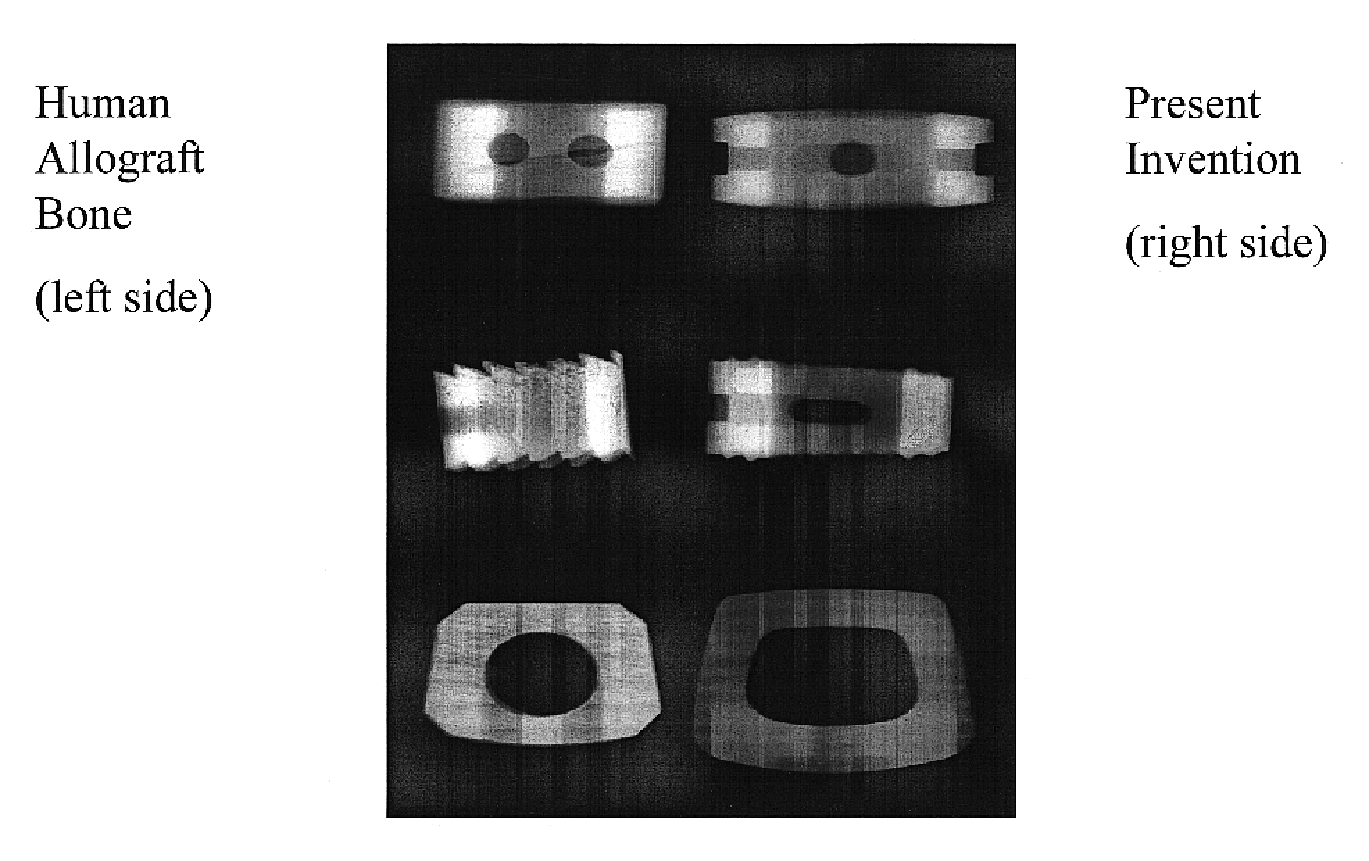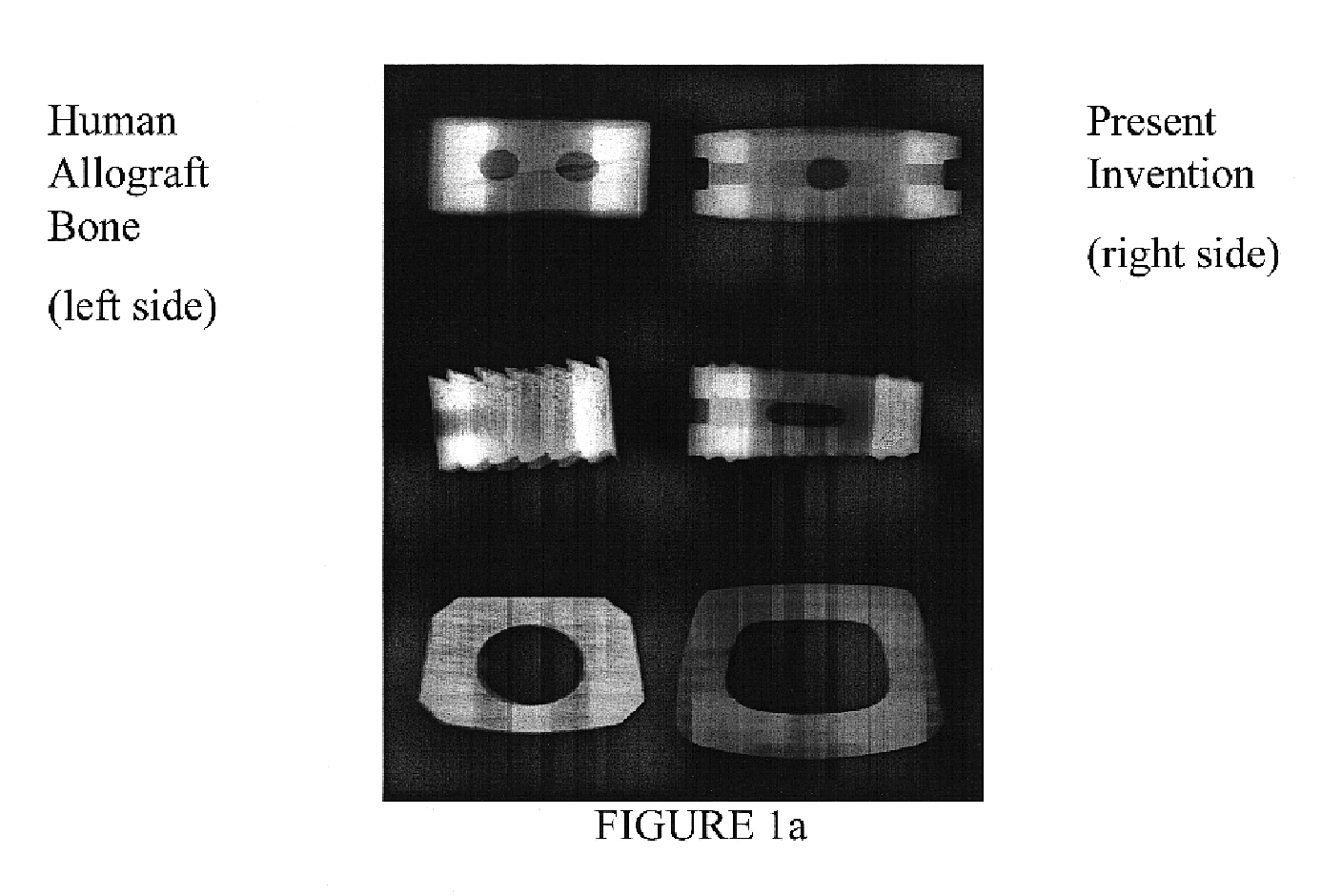Bioactive spinal implant material and method of manufacture thereof
a bioactive and spinal implant technology, applied in the field of spinal implant materials, can solve the problems of disease transmission risk, limited supply, and disadvantages of current synthetic devices, which are predominantly composed of metals such as titanium, and achieve the effects of reducing the risk of disease transmission, and reducing the cost of treatmen
- Summary
- Abstract
- Description
- Claims
- Application Information
AI Technical Summary
Benefits of technology
Problems solved by technology
Method used
Image
Examples
example 1
Bioactive Spinal Implant Material
[0054]An exemplary implant material for the manufacture of spinal implants in accordance with the invention was formulated to exhibit biocompatibility and bioactivity for bone bonding, radiopacity similar to bone in order to be able to assess fusion, mechanical strength to support physiologic loads, and bone-like stiffness to allow for good load sharing among the elements of the spine.
[0055]One implant material includes a polymeric blended resin, comprising 20% to about 50% by weight of the implant material total composition. The resin blend can be further comprised of from about 30% to about 90% by weight of resin DUDMA, about 10% to about 60% by weight of resin TEGDMA, about 0.1% to about 4% by weight of BPO, and 0% to about 0.25% by weight of butylated hydroxy toluene (BHT).
[0056]The remainder of the implant material is comprised of a plurality of fillers. The fillers can be further comprised of from about 0% to about 40% by weight of filler surfa...
example 2
Radiopacity of a Bioactive Spinal Implant Material
[0057]Qualitative Evaluation: Material of the present invention was prepared in the shape of an implant, which was placed along side an allograft implant for qualitative radiographic assessment as shown in FIG. 1a. Visually the samples had a similar radiographic appearance. In comparison to standard materials (FIG. 1b), the radiographic appearance of the material of the present invention most closely resembles bone. Variations of the present invention material can be formulated to produce variations in radiopacity as shown in FIG. 1c.
[0058]B) Quantitative Evaluation: Three tensile bar samples of polymerized bioactive material of the type described herein, approximately 4 mm in thickness, were arranged onto x-ray film, and a 16-step Aluminum step was placed on top. The 10-mm thick Aluminum step was placed so that it was partly shielding a polymerized sample and partly over x-ray film only (these materials were situated in a Faxitron ...
example 3
Mechanical Properties of a Bioactive Spinal Implant Material
[0074]Samples were prepared using the bioactive material described herein. Tests were performed using ASTM Guidelines on an Instron Model 8516 in order to obtain ranges of values of mechanical properties of the material as shown in the table below.
[0075]
TABLE IVMechanical Properties of a Bioactive Spinal Implant MaterialHUMAN CORTICALTESTRESULTBONE LITERATURECompressive Strength220-250MPa167-215MPaASTM F 451-95 & ASTMD695-91Compressive Modulus7.0-9.0GPa14.7-19.7MPaASTM F 451-95 & ASTMD695-91Compressive Yield Strength170-182MPa121-182MPaASTM F 451-95 & ASTMD695-91Tensile Strength65-100MPa70-140MPaASTM D638-98Tensile Elastic Modulus14-17GPa10.9-14.8MPaASTM D638-983-Point Flexural Strength100-120MPa103-238MPaASTM D790-90Shear by Punch Tool60-80MPa51.6MPaASTM D732-93Compressive Fatigue Strength170-190MPa>100MPa(106 cycles)Tensile Fatigue Strength35-55MPa49MPa(106 cycles)
PUM
| Property | Measurement | Unit |
|---|---|---|
| compressive strength | aaaaa | aaaaa |
| compressive strength | aaaaa | aaaaa |
| temperature | aaaaa | aaaaa |
Abstract
Description
Claims
Application Information
 Login to View More
Login to View More - R&D
- Intellectual Property
- Life Sciences
- Materials
- Tech Scout
- Unparalleled Data Quality
- Higher Quality Content
- 60% Fewer Hallucinations
Browse by: Latest US Patents, China's latest patents, Technical Efficacy Thesaurus, Application Domain, Technology Topic, Popular Technical Reports.
© 2025 PatSnap. All rights reserved.Legal|Privacy policy|Modern Slavery Act Transparency Statement|Sitemap|About US| Contact US: help@patsnap.com



